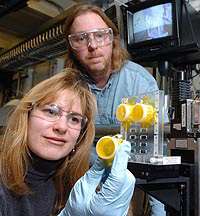APS X-rays reveal the real chemistry behind mercury mixed in mustard agent

The U.S government's effort to dispose of mustard agent from the 1940s by incinerating it was halted when workers discovered that hundreds of containers of the agent were contaminated with mercury. Researchers at Argonne and the University of Chicago used the Advanced Photon Source to determine how mercury behaves in simulant agent, a chemical that structurally resembles mustard but lacks its toxic properties. The goal is to find disposal methods that do not release toxic mercury to the environment.
The more you know about the chemistry of the mercury lurking in the mustard agent, the easier it is to select or design a technology to get rid of it, said environmental engineer and lead researcher Laura Skubal.
Mustard agent is an oily liquid that blisters skin and lungs. In compliance with the Chemical Weapons Convention, the United States is destroying its stockpiles of VX, sarin and mustard.
As plans were ramping up to burn the mustard agent, an analysis revealed that some of it contained mercury; now researchers believe that about 1,600 1-ton containers of the agent may contain high concentrations of mercury.
"We don't now how the mercury got there," said Skubal. "Back then they did not keep cradle-to-grave records on items as they do now. These containers could have held mercury for other purposes and were not cleaned before the mustard agent was stored in them." Skubal is one of Argonne 's Energy Systems Division's specialists in engineering process development.
Mercury, even at low concentrations, is extremely toxic. If the mercury were vented into the atmosphere, it could eventually settle into water, transform into methyl mercury, accumulate in fish and possibly be eaten by humans and other animals.
The mustard may still be incinerated, but special procedures will have to be put in place to ensure that the mercury is "scrubbed" out of the incinerator exhaust gas. The mercury may be removed by adding control devices including filters, wet scrubbers, and carbon absorbers — or some other process may need to be developed.
"People working with the mustard agent had assumed all the mercury was mercuric chloride and that it reacts in mustard the same way it reacts in water," Skubal said. "Our goal was to look at its chemistry and see if their assumptions were correct."
The original analysis used X-ray fluorescence and only revealed the presence of mercury. Needing more information, Argonne and University of Chicago researchers set out to:
-- Examine the chemical state of mercury after it interacted with mustard simulant.
-- Determine if treating mustard agent simulant with chemicals to detoxify it will simultaneously transform any mercury present into other mercury-containing compounds.
-- Compare how mercury interacts with water to how mercury interacts with mustard agent simulant.
-- Determine if other contaminants — specifically iron, cadmium, arsenic, and selenium — influence the chemistry of mercury in the mustard agent simulant.
Researchers did not use the actual mustard agent, but a safer, less toxic simulant called thiodiglycol. It has basically the same chemical structure of mustard agent — only one chemical group on each end of the chemical structure is different.
Argonne engineers teamed with University of Chicago researchers to use the GeoSoilEnviroCARS (GSECARS) beamline at the Advanced Photon Source (APS). The APS provides the Western Hemisphere's most brilliant X-ray beam for research and, as a Department of Energy user facility, hosts thousands of researchers from industry, academia and other research laboratories annually. The University of Chicago operates several research beamlines at the APS.
The GSECARS beamline provided a more specialized way than X-ray fluorescence of examining mercury. The beamline's X-ray absorption fine spectroscopy, explained the University of Chicago 's Matthew Newville, "lets us detect not only the presence of mercury, but also get information about its chemical state. Using the APS allows us to distinguish different chemical environments for the mercury in solution.
"We found different chemical forms of mercury in the mustard agent simulant than you find in water," Newville said.
"This is important," Skubal said," because if you are doing process chemistry, it should be based on the chemical forms in an organic matrix, not an aqueous one. They had assumed all of the mercury was in a mercuric chloride state in the agent. Our study showed that it could be mercuric sulfide or mercuric oxide, which can require different treatment methods."
Researchers also learned that small levels of cadmium and arsenic influenced which mercury compounds formed and recommended that these levels be considered in any plan to remove the mercury from the mustard agent before incineration. A typical plan might involve using bleach or caustic to detoxify the mustard – these chemicals should also be considered as they can influence how mercury will react in solution, Newville explained.
Next, Skubal and colleagues want to explore the use of various waste treatment processes on the mixtures to see which are effective in stabilizing dissolved mercury and in settling it so it can be contained and collected. If an effective process is found, it may lead to reduced costs for the disposal of mercury-contaminated agent.
Source: ANL (by Evelyn Brown)















